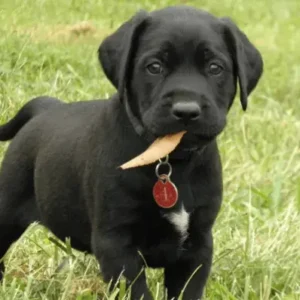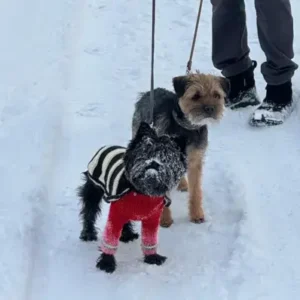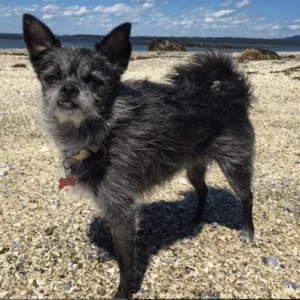Vizsla History
Sometimes known as the Hungarian Pointer, the Vizsla likely descends from hunting dogs used by the Magyars, who settled in Hungary over a thousand years ago. These dogs were used by nobles and warlords for hunting game birds and hares and were eventually developed to both point and retrieve.
Evidence of the Vizsla’s history is found in ancient art. A 10th–century etching shows a smooth-coated dog with a Magyar huntsman, and a 14th–century manuscript on falconry depicts a Vizsla-like dog.
By the 19th and early 20th centuries, the Vizsla had become a distinct breed with excellent scenting abilities, working closely with handlers. During World War I, this skilled hunting dog was also used to deliver messages.
This purebred faced near extinction after World War I and World War II, but the Vizsla survived, with the first dogs imported to the United States in the early 1950s. At that time, they looked different from today’s Vizslas, with longer muzzles, bonier top skulls, and a range of colors from chocolate brown to almost bleached out.
Vizsla History- AKC.org
The Braque du Bourbonnais like the Vizsla, is a highly skilled Hungarian hunting dog known for its tracking, pointing, and retrieving abilities. The Vizsla Club of America was established in 1954, and the American Kennel Club recognized the breed in 1960 under Sporting Group. Breeders have since standardized the Vizsla’s distinctive appearance and aristocratic bearing.
Today, the Vizsla is a beloved companion known for versatility, even participating in search and rescue at Ground Zero after the September 11, 2001 terrorist attacks. The breed is moderately popular, ranking 43rd among the 155 breeds and varieties recognized by the American Kennel Club.
Vizsla Personality
The Vizsla is one of the dog breeds that is lively, gentle, and affectionate with above-average learning ability. They are eager to please and enjoy being close to their human families.
- Temperament
Energetic and athletic, Vizslas thrive on regular physical and mental stimulation. Their strong bonds with their families make them excellent companions, especially for active individuals. With proper training and companionship, Vizslas are highly obedient and adaptable.
- Potential Challenges
Without sufficient exercise and mental stimulation, Vizslas can become bored and potentially destructive. Their high energy levels and intelligence require regular physical activity and engaging tasks to keep them occupied. If left alone for long periods or not given enough to do, they may resort to chewing, digging, or other unwanted behaviors.
Early socialization is crucial to help them grow into well-rounded adults, exposing them to various people, environments, sounds, and experiences. Consistent training and socialization are essential to prevent behavioral issues and ensure they remain well-behaved and happy companions.
Vizsla Physical Appearance
The Vizsla has a noble and well-proportioned look, being an athletic medium-sized dog. Its head is chiseled, with a long, square-shaped muzzle, a brown nose, and strong jaws. The teeth meet in a scissors bite, adding to its dignified appearance.
- Size
The Vizsla is a lightly built, medium-sized dog. Males stand 22 to 24 inches at the shoulder, while females are slightly smaller at 21 to 23 inches. Their weight ranges from 44 to 60 pounds, with females typically being on the lighter side.
- Coat color
The Vizsla sports a short, smooth coat that lies close to the body, giving it a sleek appearance. This coat comes in various shades of solid golden rust, enhancing the breed’s distinctive look. The coloration is uniform, without any markings, which adds to the Vizsla’s elegant and refined appearance.
Golden Rust Vizsla – Source: Pixabay
Vizsla Gender Differences
Male Vizslas are outgoing and sociable, spreading their affection evenly among family members, and less prone to separation anxiety. Females are independent, content with their activities near you, and may be more wary of strangers, making them potential guard dogs with proper socialization.
Vizsla Feed/Nutrition
Feed your Vizsla 3 to 4 cups of high-quality dog food daily, split into two meals. The amount may vary based on age, body type, metabolism, and activity level. Like humans, dogs are individuals with different dietary needs.
A highly active dog will require more food than a less active one. Opting for high-quality dog food ensures your dog receives optimal nutrition, reducing the quantity needed per meal. Mangoes can also be a healthy treat in moderation, just make sure to remove the pit before serving.
Vizsla Health
Vizslas are generally robust, yet like all breeds, they have predispositions to specific health issues. Not every Vizsla will develop these conditions, but prospective owners should be informed. When purchasing a puppy, seek a reputable breeder who provides health clearances for both parents.
- Epilepsy: Epilepsy is a neurological disorder that causes seizures in dogs. While it can be managed with medication, there is no cure. Dogs with epilepsy can lead full and healthy lives with proper management and care.
- Hip Dysplasia: Canine Hip Dysplasia is an inherited condition where the thighbone does not fit snugly into the hip joint, leading to pain and potential arthritis as the dog ages. Screening for hip dysplasia through organizations like the Orthopedic Foundation for Animals (OFA) is essential, and affected dogs should not be used for breeding.
- Hypothyroidism: Hypothyroidism is characterized by abnormally low levels of thyroid hormone, leading to symptoms such as obesity, lethargy, and skin issues. Daily medication can effectively manage this condition, allowing affected dogs to live normal lives with proper treatment.
- Lymphosarcoma: Lymphosarcoma is one of the most common cancers seen in dogs, affecting various parts of the body including the spleen, gastrointestinal tract, lymph nodes, liver, and bone marrow. Treatment typically involves chemotherapy, and approximately 80% of treated dogs achieve remission.
- Progressive Retinal Atrophy: Progressive Retinal Atrophy is a degenerative eye disorder that eventually causes blindness due to the loss of photoreceptors in the eye. Annual eye certifications by a veterinary ophthalmologist are crucial to ensure breeding dogs are free from this condition, as there is currently no cure once symptoms appear.
Vizsla Care and Grooming
Regular exercise, including walks, runs, and play, is essential for a happy Vizsla. Engaging in activities like canine sports or therapy work helps maintain their well-being. Alongside exercise, regular grooming is key. Use a rubber curry brush and occasionally wipe them down with a damp cloth for easy maintenance.
Trim your Vizsla’s nails once or twice a month to prevent overgrowth; if you hear them clicking on the floor, it’s time for a trim. This keeps their feet healthy and prevents accidental scratches.
Start grooming routines early, with gentle brushing and paw handling from puppyhood. Positive reinforcement during grooming will help your Vizsla stay comfortable with veterinary exams and handling as they grow.
Balancing exercise and grooming ensures a healthy, happy Vizsla. Training your dog to stay also builds discipline and strengthens your bond.
Vizsla Rescue Groups
Rescue organizations occasionally have Vizslas available for adoption. These dogs may need a new home due to unforeseen circumstances or previous owners’ unable to care for them. Adopting a rescued Vizsla can be a rewarding experience, offering a chance to provide a loving home to a dog in need.
How Much Does Vizsla Cost?
The price of a Vizsla typically ranges from $1,000 to $3,000, depending on factors such as breeder reputation, pedigree, and location.
Vizslas are often available for sale from reputable breeders who prioritize the health and welfare of their dogs. When purchasing a Vizsla puppy, it’s crucial to find a responsible breeder who conducts health screenings and provides proper socialization for their puppies. Avoid purchasing from puppy mills or irresponsible breeders who prioritize profit over the well-being of their animals.
Interesting Facts
- The Vizsla was cherished as the Austro-Hungarian empire’s premier hunting dog, bred by aristocrats for their adept pointing and retrieving skills.
- Vizslas consistently display a golden rust-colored coat without variation. Their brown eyes harmonize seamlessly with this coat, aiding in effective camouflage during hunting.
- Vizslas played a crucial role in search and rescue efforts immediately following 9/11.
- They have appeared in the Westminster Kennel Club Dog Show in 2024.
- Kevin Love has owned a Vizsla as a pet.
Kevin Love- Source: People
Best For
The Vizsla is ideal for active individuals or families who can provide plenty of exercise, mental stimulation, and companionship. They thrive with consistent training and socialization, making them great for those who enjoy outdoor activities and dog sports.
Top Names
| Male Vizsla Names | Female Vizsla Names |
| Max | Bella |
| Cooper | Luna |
| Charlie | Daisy |
| Duke | Sadie |
| Hunter | Ruby |









 Vizsla History-
Vizsla History- 

 Golden Rust Vizsla – Source:
Golden Rust Vizsla – Source: 
 Kevin Love- Source:
Kevin Love- Source: 






